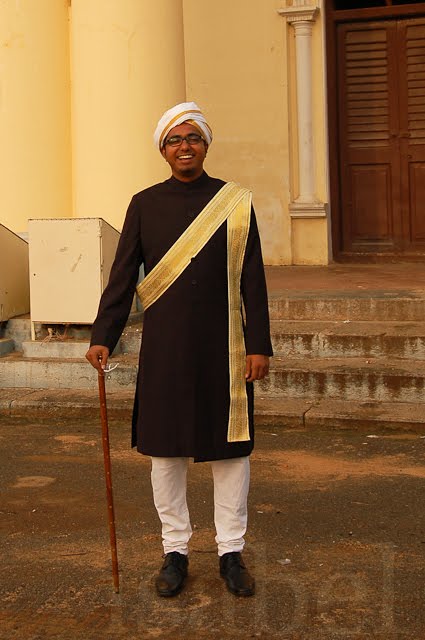While in Mysore, I had the chance to take in a city walking tour with Royal Mysore Walks. This was a unique way to see the city, guided by locals who know Mysore inside out and all it has to offer.
Vinay Parameswarappa (the founder), Vinay Nagaraju and Manu Bharadwaj of Royal Mysore Walks describe themselves as ‘corporate dropouts’: each of them left a high-flying but soul-destroying job in Bangalore to devote themselves to promoting the cultural heritage of Mysore, a city which is close to their hearts.
For close to three years, they have been sharing their passion and knowledge with visitors by taking them around their city, sharing interesting facts about this former kingdom, and showing them not only the many majestic palaces and monuments, but also offering fascinating glimpses into local life that many on the typical tourist trail often miss.
This being Dasara and Mysore’s most important festival, the Royal Mysore Walks team have planned a series of special Dasara walks during the 10-day festival.
Vinay P, our guide for the Dasara Royal Walk, was all decked up in traditional ‘Durbar dress’. He explained that the city’s menfolk used to wear turbans (called ‘peta’) in the Maharaja’s day, and that the way the peta was worn indicated the person’s social standing. Vinay P was dressed up the way a minister would dress if he was invited to the Maharajah’s private durbar. Of course, no one dresses like this anymore, so a lot of research went into assembling the costume. His black overcoat had a high neck and was collarless, with six buttons running down the front. He wore a silk sash over his left shoulder. The most important part of the costume was of course the peta. The Royal Mysore Walks team managed to find someone from a family which was specialised in tying these elaborate turbans during the days of the Mysore kingdom, who gave them a crash course in turban-tying for ministers. The elegant period costume was completed with a walking stick. As our dapper guide led us through the streets of Mysore, he got quite a few curious looks and questions from the locals!
The Dasara walks also generated a lot of media interest. Journalists from local television and newspapers showed up to interview the team. They were featured in all the major newspapers the next day, as well as on television.
During the Royal Walk, we witnessed the preparations for the Mysore Dasara, which was the topic of my previous post.
Here are a few glimpses of other things we saw during our walk that day:
Guru Sweet Mart, located just outside Devaraja market, is famous for its Mysore Pak which was invented by this man’s great grandfather, Kakasara Madappa.
Pomegranate sellers and other colourful scenes from Devaraja market, a bustling 125-year-old market with more than 700 stalls.
Artisans doing inlay work in the neighbourhood of Mandi Mohalla, the home to many artists specialised in this intricate handicraft.
Sculpture students busy at work at Chamarajendra Academy of Visual Arts (CAVA)
Vinay N. and Vinay P., part of the passionate team at Royal Mysore Walks.
To learn more about their walks and other activities, visit their website.























3 comments :
Love this post and especially the photos! I hope to go to Mysore one day and will certainly look these fellows up for a walking tour :)
isabel you look like a flower :)
Do you mean my profile image? Yes, it's indeed a flower!
Post a Comment